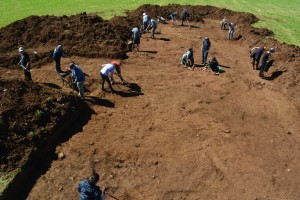The project was designed to undertake research and excavation on enclosures and hillforts in the Lammermuirs as part of the overall Rampart Scotland aims, to provide a corpus of data to compare and contrast with the existing information. The Sheriffside enclosure is located in a silage field, immediately to the north of Sheriffside Farm, Gifford, East Lothian (NT 55505 67739). The enclosure is located on the south eastern edge of a low southwest–northeast ridge.
This project aimed to add detail to the existing rectified aerial photograph (first recorded in the 1980s by the RCAHMS ) and to provide an assessment of the nature of the surrounding archaeological remains and a date for it.
We had already carried out a successful keyhole excavation in 2012 – and this season expanded on the zone of massive ditches and palisades.
Trench 4 was excavated by hand to provide a larger sample of the features identified in 2012 – the work revealed four palisade features and three ditches one of which contained an assemblage of Iron Age pottery within a charcoal rich tip layer.
Five sondages (A, B, C, D & E) were excavated across features identified within Trench 4;
- Sondage A was orientated East-West 2.8m by 3.8m and was intended to explore Ditches 1 and 2.
- Sondage B was an irregular shape and measured up to 2m wide and 7.5m long and was intended to characterise Ditch 4.
- Sondage C was orientated North-East South-West and measured 0.25m by 2m and was intended to characterise Palisade 3 (Ditch 3 from the 2012 Season) and the relationship with Ditch 4.
- Sondage D was orientated North-South and measured 1m x 1.50m and was used to investigate Palisade 3
- Sondage E was orientated North-East South-West and measured 1m by 7m and was intended to identify the presence of Palisade 4.
The radiocarbon dates from both seasons indicate nine broad periods of activity:
- c791-703 BC: Palisade 3;
- c766-486 BC: Palisade 2;
- c378-202 BC: Palisade 1;
- c120 BC-AD 60: scooped settlement from 2011 season;
- cAD 58-125: Ditch 4 tip lines on partly filled ditch (contemporary with occupational internal activity);
- cAD 126-260: Ditch 4 upper fill – Ditch now completely filled;
- pre cAD 211-384: Ditch 2, is cut and filled prior to Ditch 1 cut –currently undated;
- cAD 211-384: Ditch 1, ditch cut before this point and filled after it;
- after cAD 211-384: Palisade 4.
Slight overlaps in some of these periods make it possible that they represent one period of activity, although for the sake of argument it is assumed that they are not. On this basis, the dates clearly indicate a shifting pattern from light defence to open settlement to more heavily defended settlement, although both the duration and nature of the associated activity within the various phases of enclosure are unclear. There is of course a final phase of undated activity, the backfilling of Ditch 1., however, the discovery of palisade 4 now suggests that we have an early Medieval presence in teh5th century.
The overall sequence at Sheriffside contains many of the elements detected at other enclosed sites in East Lothian (Haselgrove 2009), for example Late Iron Age scooped settlement which could either be open or associated with an enclosure; Early to Late Iron Age defences; the refortification of existing sites in the Roman Iron Age. However, there are a number of key differences: for example the majority of the palisades excavated and dated in the Traprain Law Environs Project are Late Bronze Age in date, although the example from Standingstone did have an Iron Date that was dismissed by excavator as intrusive (op cit, 60). In addition, no single site appears to have had multiple phases of enclosures from the Early Iron Age to the Late Roman Iron. In addition, with the exception of Dunbar (Perry 2005, 25; Haselgrove 2009, 231), no other de novo ditches were dug in East Lothian during the Roman Iron Age. These differences do not contradict the established sequence but certainly establish the potential for previously unknown complexity to reside in unexcavated sites. Certainly more detailed examination of the comparanda reveals interesting patterns.
For example, the Dunbar ditch is less than half the size of Ditch 1 (Perry 2005, 25), presumably this can be taken to mean that Sheriffside was a significant location in the Roman Iron Age to Early Medieval period. The absence of Roman finds from the site, is echoed at other contemporary sites, with the exception of Traprain Law (Haselgrove 2009, 231), and certainly raises interesting questions about the function of the Sheriffside enclosure in this period.
Thanks
We would like to thank Eric Glendinning for suggesting the site and allowing access onto his land, and volunteers of all ages who helped make this possible.
Sheriffside, East Lothian :: Full interim report 2014
Connolly D. and Cook M. et al, 2014, Rampart Scotland Project 003: Sheriffside, Gifford, East Lothian. Data Structure Report (pdf)


